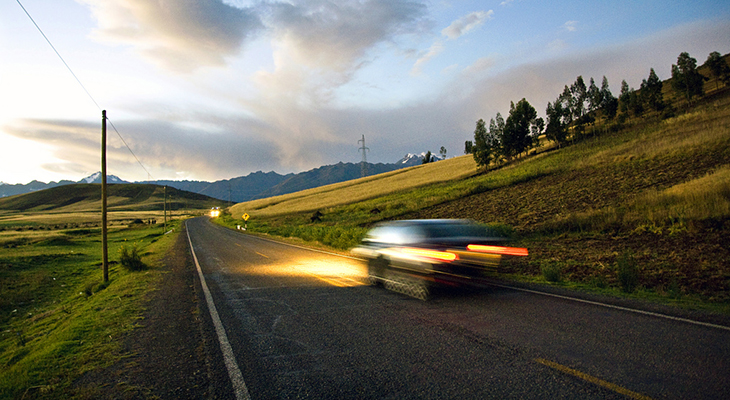Watching The Car And Shaking The Wheel To Wake Sleepy Drivers

Image credits: Dimitry B via Flickr
(Inside Science) -- Researchers at Clemson University said the key to new technologies designed to reduce accidents caused by sleepy or text-happy drivers is to watch the car, not its driver.
If their research can be adapted for new cars, fatigue, a major cause of severe accidents, could be managed, they said.
The number of crashes caused by fatigue is unclear. According to the National Highway Traffic Safety Administration, between 2005 and 2009, 2.2 percent of all fatal crashes involved drivers falling asleep. It reported 72,000 crashes, 800 fatalities and 44,000 injuries.
But, a study at Virginia Tech in 2013 of 100 car drivers in the Washington, D.C.-Northern Virginia area indicated that as much as 20 percent of accidents involved fatigued drivers. Drivers 18 to 20 years old are the most likely to get involved in a fatigue-induced accident, probably because of maladjusted sleep cycles, a common issue for people of that age.
The percentage of fatigue-influenced crashes is probably higher even than that: The causes of many crashes are never determined, and data are incomplete.
Safety engineers have begun to design electronic devices to address the problem. Computers in today’s cars can watch almost everything that happens with a car, giving engineers data to help detect fatigue.
Car companies have added new technologies to their newest cars, including systems that monitor when a car changes lanes and when another car enters a driver’s blind spot. Some technology even brakes the car if it senses an imminent accident. Each system improves safety.
But if a driver is asleep or just dozing off, the warning might be too late or go unnoticed. The goal is to develop technology that can see when that is happening and warn the driver.
“For many years ... [engineers] were really focusing on the drivers themselves,” said June J. Pilcher, professor of psychology at Clemson University in South Carolina.
Many current methods watch for behaviors such as head nodding, frequent blinking, eyelids staying shut for a long time, and eye rubbing, said Shane McLaughlin, a research scientist at the Virginia Tech Transportation Institute in Blacksburg.
Engineers have even experimented with monitoring brain waves.
"Drowsiness detection through biometrics alone is difficult, prone to error … and can be intrusive by interfering with the normal execution factions,” the Clemson scientists wrote in a paper published in Accident Analysis and Prevention.
Some technologies watch both the driver and the car.
Mercedes-Benz’s Attention Assist technology tracks what a driver does with a car in the first minutes he or she begins a drive. The system measures steering behavior and 69 other parameters and then measures what that driver does during the rest of the trip, looking for deviations in driving habits. It also monitors outside conditions such as cross winds to see if they might play a role in deviations. If it concludes the driver is distracted, it sounds an alarm and flashes a warning on the dashboard.
It is a standard feature on most Mercedes.
Pilcher, graduate student Drew Morris and Fred S. Switzer say that just watching how a driver maneuvers a car in the lanes, particularly while making turns, would be more accurate and less intrusive.
Almost all drivers normally deviate a bit from straight, smooth paths, with deviations greater during turns. Clemson’s system accounts for that and looks for deviations greater than what would normally be expected.
“The car could be off the side of the lane and still be under perfect control,” Morris said. The Clemson system would decide when erratic behavior, such as swerving, results from a loss of control.
The researchers kept 20 subjects, all students, awake overnight and then put them in driving simulators to test how they did on a route with nine curves. They found that during multiple trials, the subjects showed several signs of early stage fatigue, such as slower reaction times in general.
Based on what they saw with the students they proposed a system that would watch the car, making use of a GPS system, a computer to monitor a car's direction and one more computer to analyze the data.
Pilcher said she didn’t know whether current auto GPS systems are accurate enough for this task. McLaughlin said he did not think so, but they could be made more accurate. Even improving them to be just a meter (three feet) off, would not be of much help, McLaughlin said. Also, current GPS systems only check position once a second, not fast enough.
On advantage of highly accurate GPS monitoring is that it also could warn if a driver becomes distracted, for instance, by picking something up from the floor or texting or reading email, Morris said.
Pilcher said she thought a shaker stick, a device in airplane control yokes that vibrates if a plane is nearing a stall, could help.
In this case, the steering wheel would shake, the fastest way to get a driver’s attention.
"I think the technology is here, but it is not being utilized in this way,” Morris said.

